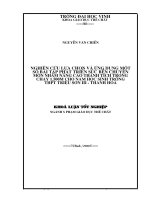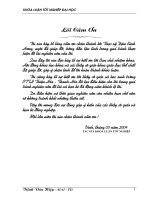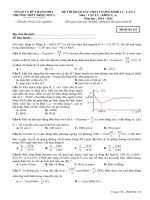Tải Đề thi học sinh giỏi môn Tiếng Anh lớp 11 trường THPT Triệu Sơn 4, Thanh Hóa năm 2015 - Đề thi học sinh giỏi môn Tiếng Anh lớp 11 có đáp án
Bạn đang xem bản rút gọn của tài liệu. Xem và tải ngay bản đầy đủ của tài liệu tại đây (156.22 KB, 10 trang )
<span class='text_page_counter'>(1)</span><div class='page_container' data-page=1>
<b>SỞ GIÁO DỤC VÀ ĐÀO TẠO</b>
<b> THANH HÓA</b>
<b>TRƯỜNG THPT TRIỆU SƠN 4</b>
ĐỀ CHÍNH THỨC
<b>KÌ THI CHỌN ĐỘI TUYỂN HỌC SINH GIỎI </b>
<b> Năm học: 2015 - 2016</b>
<b> Môn thi: Tiếng Anh</b>
<b> Lớp 11 THPT </b>
Ngày thi: 20/5/2015
Thời gian: 150 phút (không kể thời gian giao đề)
Đề này có 06 trang
<i><b> Họ và tên thí sinh: ……….Phòng thi: ……….. Số báo danh: ……….. </b></i>
<b>PART A . PHONETICS : (5.0 point)</b>
<b>Question I : Circle one letter A, B, C, or D to indicate the word whose main stress pattern is different from the others.</b>
<i><b>(2.0 point)</b></i>
1. A. Perform B. Campus C. Mountain D. Equal
2. A. Information B. Contaminate C. Mathematics D. Politician
<b>Question II: Circle one letter A, B, C, or D to indicate the word whose underlined part is pronounced differently </b>
<i><b>from that of the others. (3.0 point)</b></i>
3. A. Closure B. Pleasure C. Conclusion D. Pressure
4. A. Walked B. Threatened C. Passed D. Forced
5. A. Streets B. Phones C. Books D. Makes
<b>PART B. GRAMMAR AND VOCABULARY (45.0points)</b>
<b>Question I : Circle the letter A, B, C, or D to indicate the correct answer to each of the following questions. (15.0 points).</b>
1.. ………… the time you get to the theatre, the play will have finished.
A. Until B. In C. By D. On
2. They are going to make ……… excursion next month.
A. a two-week B. two-weeks C. two weeks' D. a two-week
3. He refused to give up work , ……… he had won a million pounds.
A. despite B. however C. even though D. as though
4. The new system didn’t …………... expectations.
A. catch up with B. bring about C. come across D. come up to
5. The newspaper report contained ……… important information.
A. many B. another C. an D. a lot of
</div>
<span class='text_page_counter'>(2)</span><div class='page_container' data-page=2>
A. would B. should C. had D. did
7. Helen asked me ……… the film called “Stars Wars”.
A. have I seen B. have you seen C. If I had seen D. if had I seen
8. She had no . ……… of selling the clock. It had belonged to her grand mother.
A. intention B. meaning C. interest D. opinion
9. I’m really looking forward ……… to university.
A. to go B. go C. going D. to going
10. Let’s go dancing, ………?” - “Yes, let’s”
A. will we B. do we C. don’t we D. shall we
11. I don’t want much sugar in my coffee. Just……., please.
A. few B. a few C. little D. a little.
12. They are very happy to have received a(n) ... of 500 dollars from a foreign company.
A. charity B. donation C. hospital D. organisation
13. were so late that we ……… had time to catch the train.
A. nearly B. almost C. hardly D. mostly
14. Many species of animals have become …… due to the irresponsible activities of people.
A. endanger B. dangerous C. danger D. endangered
15.- “Would you like to have noodles, spaghetti or something different?” - “………….”
A. Anything will do B. Yes, please C. Never mind D. I don’t mind
Question<b> II : Fill in the blanks with the correct form of the words in capital letters. (10.0 point)</b>
1. Earth Hour is a ...event organized to raise people’s awareness about the need to take action on climate
change. (WORLD)
2. Solar energy, wind power and water power are ...sources of energy. <b>(ALTERNATE)</b>
3. This organization is very concerned about the……...of the rain forests. (DESTROY)
4. In Western countries, electricity, gas, and water are not luxuries but ... . <b>(NECESSARY)</b>
5. Two……...from the group “Friends of the Earth" are talking to the students. <b>(REPRESENT)</b>
6. What does it mean to say “ the world is ……… ? <b>(OVERPOPULATE)</b>
7. Seven ………countries have arrangements to deliver EMS items. <b>(ADD)</b>
</div>
<span class='text_page_counter'>(3)</span><div class='page_container' data-page=3>
<b>Your answers</b>
1. 2. 3. 4. 5.
6. 7. 8. 9. 10.
<b>Question III: The passage below contains 10 mistakes. UNDERLINE the mistake and WRITE THEIR CORECT </b>
<i><b>FORMS in the space provided in the column on the right. (0) has been done as an example ( 10.0 points)</b></i>
The horse and carriage is a thing of the past, but love and marriage are still
with us and still closely interrelating. Most American marriages, particular
first marriages uniting young people, are the result of mutual attraction and
affection rather with practical considerations.
In the United States, parents do not arrange marriages for their children.
Teenagers begin date in high school and usually find mates through their own
academic and social contacts. Though young people feel free to choose their
friends from different groups, almost choose a mate of similar background.
This is due partly to parental guidance. Parents cannot select spouses for their
children, but they can usually influence choices by voicing disapproval for
someone they consider suitable.
However, marriages of members of different groups (interclass, interfaith, and
interracial marriages) are increasing, probably because of the greater mobile of
today's youth and the fact that they are restricted by fewer prejudices as their
parents. Many young people leave their hometowns to attend college, serve in
armed forces, or pursue a career in a bigger city. One away from home and
family, they are more likely to date and marry outside their own social group.
0. __ interrelated ____
1. ________________
2. _________________
3. _________________
4. _________________
5. _________________
6. _________________
7. _________________
8. _________________
9._________________
10._________________
<b>Question IV: Put each verb in brackets into an appropriate form. (10pt )</b>
1. A - Stop! You (not see) ……… the notice?
B - I see it but I can’t read it. What it (say) ………….. ?
2. That man was a little mad. He always (try) ……….to improve that the earth was flat.
3. Something tells me that you (not listen) ……….to a single word I have said in the past ten minutes.
4. I’m so confused that I don’t know what (do) ……….. .
5. Smith had a lucky escape. He (kill) ………. .
<b>PART D. READING (30.0 points)</b>
<b>Question I: Fill in each numbered blank with ONE appropriate word: ( 10.0 points)</b>
</div>
<span class='text_page_counter'>(4)</span><div class='page_container' data-page=4>
Books is a poor man. Books have become so cheap that a library can easily be made. Money spent on good books is
never (4)………. It is a pleasure to read good books. Thus man gains both efficiency and wisdom. You can(5)
…… your library with the expenditure of only a few hundred rupees.
<b>Your answers</b>
1. 2. 3. 4. 5.
<b>Question II : Read the passage and circle the letter A, B, C or D to indicate the correct answer to each of the </b>
<i><b>questions (10.0 points )</b></i>
Large animals that inhabit the desert have evolved a number of adaptations for reducing the effects of extreme heat.
One adaptation is to be light in color, and to reflect rather than absorb the Sun's rays. Desert mammals also depart from
the normal mammalian practice of maintaining a constant body temperature. Instead of trying to keep down the body
temperature deep inside the body, which would involve the expenditure of water and energy, desert mammals allow
their temperatures to rise to what would normally be fever height, and temperatures as high as 46 degrees Celsius have
been measured in Grant's gazelles. The overheated body then cools down during the cold desert night, and indeed the
temperature may fall unusually low by dawn, as low as 34 degrees Celsius in the camel. This is an advantage since the
heat of the first few hours of daylight is absorbed in warming up the body, and an excessive build-up of heat does not
begin until well into the day.
Another strategy of large desert animals is to tolerate the loss of body water to a point that would be fatal for
non-adapted animals. The camel can lose up to 30 percent of its body weight as water without harm to itself, whereas
human beings die after losing only 12 to 13 percent of their body weight. An equally important adaptation is the ability
to replenish this water loss at one drink. Desert animals can drink prodigious volumes in a short time, and camels have
been known to imbibe over 100 liters in a few minutes. A very dehydrated person, on the other hand, cannot drink
enough water to rehydrate at one session, because the human stomach is not sufficiently big and because a too rapid
dilution of the body fluids causes death from water intoxication.
The tolerance of water loss is of obvious advantage in the desert, as animals do not have to remain near a water hole
but can obtain food from grazing sparse and far-flung pastures. Desert-adapted mammals have the further ability to
feed normally when extremely dehydrated, it is a common experience in people that appetite is lost even under
conditions of moderate thirst.
1. What is the main topic of the passage?
A. Weather variations in the desert B. Adaptations of desert animals
C. Diseased of desert animals D. Human use of desert animals.
2. According to the passage, why is light coloring an advantage to large desert animals?
A. It helps them hide from predators B. It does not absorb sunlight as much as dark colors
C. It helps them see their young at night D. It keeps them cool at night
3. The word "maintaining" in the first paragraph is closest in meaning to
A. measuring B. inheriting C. preserving D. delaying
4. The author uses of Grant's gazelle as an example of
A. an animal with a low average temperature
</div>
<span class='text_page_counter'>(5)</span><div class='page_container' data-page=5>
C. a desert animal that can withstand high body temperatures
D. a desert animal with a constant body temperature
5. When is the internal temperature of a large desert mammal lower?
A. Just before sunrise B. In the middle of the day
C. Just after sunset D. Just after drinking
6. The word "tolerate" in the second paragraph is closest in meaning to
A. endure B. replace C. compensate D. reduce
7. What causes water intoxication?
A. Drinking too much water very quickly B. Drinking polluted water
C. Bacteria in water D. Lack of water.
8. What does the author imply about desert-adapted mammals?
A. They do not need to eat much food. B. They can eat large quantities quickly
C. They easily lose their appetites. D. They can travel long distances looking for food.
9. Why does the author mention humans in the second paragraph?
A. To show how they use camels. B. To contrast them to desert mammals.
C. To give instructions about desert survival. D. To show how they have adapted to desert life.
10. Which of the following is NOT mentioned as an adaptation of large desert animals?
A. Variation in body temperatures B. Eating while dehydrated
C. Drinking water quickly D. Being active at night.
<b>QuestionIII: Read the following passage and circle the most suitable answer (A,B,C or D) for each space: (10.0</b>
<i><b>point)</b></i>
The computer is undoubtedly one of the most (1) ... and important inventions of the twentieth century.
Boring or time-consuming jobs which, in the past, would have been carried out by hundreds of workers can now be
done by one small computer. However, the (2)... of the computer has not been entirely problem-free.
Many people feel that we are already too dependent on computers. They think that computers themselves are becoming
too powerful, and that people are no longer in control of them.
One of the problems with a computer is that, like any other machines, it can (3)... If a computer is
damaged, the information it is storing can be lost. If a computer program has a(n) (4)... in it, the
computer’s calculation can be seriously (5)... . A faulty program in a hospital or police computer could
cause terrible mistakes.
</div>
<span class='text_page_counter'>(6)</span><div class='page_container' data-page=6>
4. A. foul B. abnormality C. wrongdoing D. error
5. A. devalued B. affected C. fooled D. broken
<b>PART E. WRITING (20.0 points)</b>
<b>Question I : Finish each second sentence so that it has similar meaning to the first sentence, using the clues at the beginning</b>
<i><b>of each sentence. There’s an example at the beginning (0). (5.0 points)</b></i>
0. Can you close window, please? <sub></sub> Would you mind closing the window?
1. “I am sorry that I broke the glass” said Jim.
=> Jim apologised ……….. .
2. I really think you ought to take some exercises.
=> It is high time ………
3. If we can solve the problem soon, it will be better for all concerned.
=> The sooner ……….
4. The demand was so great that they had to reprint the book immediately.
=> So ……….
5. I prefer going out for a meal to staying at home.
=> I’d rather ………..
<b>Question II: Write the new sentences using the given word. Do not change the word given in any way. (5.0 pts)</b>
1. They have discovered some interesting new information. <b>(LIGHT)</b>
=> ……….
2. They suspended Jack for the next two matches. <b>(BANNED) </b>
=> ……….
3. I really want to see her again. <b>(DYING)</b>
=> ……….
4. She was so beautiful that I couldn't stop looking at her. <b>(EYES) </b>
=>………
5. We are looking forward to watching the program. <b>(WAIT)</b>
=>………
</div>
<span class='text_page_counter'>(7)</span><div class='page_container' data-page=7>
<i> In the future, students may have the choice of studying at home by using technology such as computers or television</i>
<i>or of studying at traditional schools. Which would you prefer? Use reasons and specific details to explain your choice.</i>
………
………
………
………
………
………
………
………
<i><b> THE END </b></i>
<b>---SỞ GIÁO DỤC VÀ ĐÀO TẠO</b>
<b> THANH HĨA</b>
<b>TRƯỜNG THPT TRIỆU SƠN 4</b>
HD CHẤM CHÍNH THỨC
<b>KỲ THI CHỌN ĐỘI TUYỂN HỌC SINH GIỎI </b>
<b>Năm học: 2015 - 2016</b>
<b>Môn thi: Tiếng Anh</b>
<b>Lớp 11 THPT</b>
<i>Ngày thi: 20/5/2015</i>
<i>Hướng dẫn chấm gồm 03 trang.</i>
<b>A- ĐÁP ÁN:</b>
<b>PART A: PHONETICS (5 điểm – Mỗi câu đúng 1 điểm)</b>
1. A 2. A 3. D 4. B 5. B
<b>PART B: VOCABULARY & GRAMMAR (45 điểm)</b>
<b>Question I.( 15 điểm – Mỗi câu đúng 1 điểm)</b>
1. C 2. A 3. C 4. D 5. D
6. C 7. C 8. A 9. D 10. D
11. D 12. B 13. C 14. D 15. A
</div>
<span class='text_page_counter'>(8)</span><div class='page_container' data-page=8>
1. worldwide 2. alternative 3. destruction 4. necessities 5. representatives
6. overpopulated 7. additional 8. commonly 9. accompanying 10. annually
<b>Question III; (10 điểm – Mỗi câu đúng 1 điểm - nếu tìm được lỗi mà sửa khơng đúng thì cho 0.5 điểm)</b>
<b>MISTAKES</b> <b>CORRECTIONS</b> <b>MISTAKES</b> <b>CORRECTIONS</b>
1. particular particularly 6. suitable unsuitable
2. with than 7. of between/ among
3. date dating/ to date 8. mobile mobility
4. almost most 9. as than
5. for of 10. one once
<b>Question IV: ( 10 điểm - Mỗi câu đúng 2 điểm)</b>
1. Don’t you see/ does it say 4. should been done
2. Was always trying 5. Could have been killed
3. haven’t been listening
<b>PART C: READING COMPREHENSION (30 pts)</b>
<b>Question I: ( 10điểm - Mỗi câu đúng 2 điểm)</b>
1.about 2.index 3.without 4.wasted 5.form
<b>Question II. ( 10 điểm - Mỗi câu đúng 1 điểm)</b>
1. B 2.C 3.C 4.A 5.A
6. B 7.D 8.D 9. B 10.D
</div>
<span class='text_page_counter'>(9)</span><div class='page_container' data-page=9>
1.B 2.C 3.B 4.D 5.B
<b>PART D: WRITING (20 pts)</b>
<b>Question I (5 điểm - Mỗi câu đúng 1 điểm)</b>
1. Jim apologised for breaking the glass.
2. It is high time you took some exercises.
3. The sooner we can solve the problem, the better it will be for all concerned.
4. So great was the demand that they had to reprint the book immediately
5. I’d rather go out for a meal than stay at home.
<b>Question II (5 điểm- Mỗi câu đúng 1 điểm)</b>
1. <i>Some interesting new information has come to light</i>
2. <i>Jack was banned from playing in the next two matches.</i>
3. <i>I'm dying to see her again.</i>
4. <i>She was so beautiful that I couldn't take my eyes off her.</i>
5. <i>We can't wait to watch the program.</i>
<b>Question III. Essay: (10 điểm)</b>
<b>Marking criteria: </b>
<b>+ Task completion (4 điểm)</b>
</div>
<span class='text_page_counter'>(10)</span><div class='page_container' data-page=10>
<b>+ Grammatical accuracy and spelling 3 điểm: bài viết khơng có lỗi chính tả và từ ba lỗi ngữ pháp trở xuống được</b>
cho 3 điểm tối đa. Cứ 4 lỗi chính tả hoặc ngữ pháp trừ 1 điểm (Trừ không quá 3 điểm).
<b>- Coherence and cohesion (tính mạch lạc và sự liên kết câu, đoạn) – 3 điểm: </b>
Tùy mức độ mạch lạc, liên kết câu, liên kết đoạn của bài viết, giám khảo có thể chấm 1-3 điểm.
<b>B - HƯỚNG DẪN CHẤM:</b>
<b>Bài thi chấm theo thang điểm: 20</b>
<b>Điểm bài thi làm tròn đến 0,25</b>
</div>
<!--links-->









